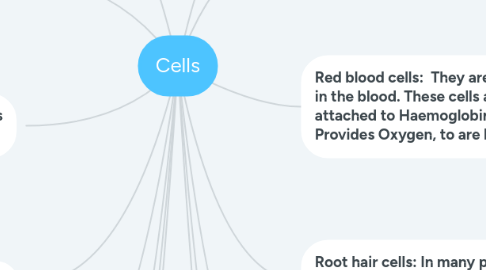
1. Animal cell
2. Chlorplats: Absorbs light and energy to to make food.
3. Cell specialisation: Different cells carry out different jobs.
4. Human sex cells:
4.1. Sperm cell: They carry out a few functions in the body, and fertilizes the Egg cell.
4.1.1. Egg cell: A large cell, that cant move on its own. But the cytoplasm provides, nutrients.
5. Ciliated cells: They are found in the repository tract, and moves a liquid called muscus. It sweeps out dust and bacteria.
6. Size of specimens
6.1. We can use a formula to figure out the magnification. Example: Actual size = Observed size / Magnification
7. Diffusion in cells
7.1. Carbon dioxide entering leave cells
7.1.1. Digested food substances from the small intestine entering the blood.
8. Osmosis in plants: if a cell is placed with a higher concentration of solute, than the cytoplasm will shrink. The H20 can leave the cell
8.1. Water molecules move down the water potential gradient.
9. Cell structure
9.1. Cell Membrane: A layer that surronds the cell
9.1.1. Cytoplasm: Many chemical reactions takes place here.
9.1.1.1. Nucleus: Controls how the cell grows and works.
10. Plant cell
10.1. Cell wall: The surrounding of the cell
10.1.1. Vacuole: It used for storage of some materials, and to support the plant.
11. Red blood cells: They are found in the blood. These cells are attached to Haemoglobin. Provides Oxygen, to are bodies.
11.1. White blood cells
11.1.1. Phagocytes: Eat dirt, bacteria, and dead / dying cells
11.1.1.1. Lymphocytes: Made in bone marrow, and has a giant nucleus.
11.1.1.1.1. B Lymphocytes: They make antibodies shaped like proteins.
12. Root hair cells: In many plants, water and minerals are absorbed from the soil of the root hairs.
13. Palisade mesophyll cells: They are found in the upper part of the leaf. It has lots of chloroplasts for phosysnthsis.
14. Movement in and out of the cells. There are different function in cells.
14.1. Diffusion: When particles are moving around. From high concentration to a low concentration.
14.1.1. Concentration gradient: When sugar molecules spread from a high concentration to a low concentration.
14.1.1.1. Net movement: When there are particles moving in one direction.
14.2. Net movement: The overall movement of particles going in one direction.
15. Osmosis: When water particles diffuse through partially permeable membranes.
15.1. The result of a passive process , and random movement of particles.
15.1.1. The concentration of water molecules.
15.1.1.1. Water potential
15.1.1.1.1. When solutes are added to water, its potential can fall.
